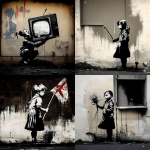Thanks to Midjourney and Open AI (which includes ChatGPT and Dall E) people are able to enter a prompt and receive an image or body of text. Since the images and text can be quite good, this has launched a plague of think pieces on the subject, many of which foretell doom for creativity. As a professor, I have also had to listen to fears that ChatGPT and its fellows will usher in a new age of cheating. While I have been thinking about AI for a long time (I did my first debate on it in the 1980s), I have been waiting a bit to write about the latest AI craze—I wanted to think about it in some depth before rushing into the fray once more.
In addition to being a professional philosopher, I also create stuff for tabletop role playing games like D&D and Call of Cthulhu. In addition to writing text content, I also create maps and images for my work. As such, I am technically in the creative class affected by the new AI image and text creators. I make note of this to disclose this as a potential biasing factor. After all, some say that AI is poised to eliminate both professors and creatives. In this essay, my concern is with my creative hobby rather than with my main profession. My concern is also with the economic aspects of the situation. In other essays I will inflict my opinion on whether AI images and text can be art.
Looking back into the shallow depths of human history, we can see that professions are regularly changed or eliminated by various economic shifts. To illustrate, fads in fashion or food can result in significant economic changes. As an example, beaver trapping was once a major economic factor in America because of the use of beaver pelts in men’s hats. But the fur trade era came to an end, and you rarely hear of beaver trapping these days. In other cases, the change is based in technology. For example, my home area of New England was once known for its whaling industry and whale oil was used extensively for lighting. When alternatives, such as kerosene, became available, then this whaling industry came to an end. As such, New Englanders rarely work as whalers these days. Kerosene was itself largely replaced by electricity, also resulting in changes in available jobs. And, of course, there is the specific technological change of automation, when machines reduce or eliminate the need for human workers.
For most of human history, machines tended to eliminate or reduce physical jobs—although there is the obvious example that electronic computers eliminated the need for human computers. Back when I first debated about AI as an undergraduate, there was a general view that AI would not be able to engage in creative activity. This was sometimes presented in terms of the view that machines would never be able to feel (which was assumed to be critical for creativity) or that there was some special human trait of creativity that a machine could not replicate. As a practical matter, this seemed to hold true until recently when AI started producing very good images and high-quality text; good enough to easily pass as created by competent humans. While this had caused considerable concern in various areas, a very practical worry is that AI will put creatives out of work. After all, if a business can get text and images created by AI for a minuscule fraction of what it would cost to pay a human for the same work, a sensible business will turn to AI since the end is maximizing profit.
This, obviously, shows that the true problem is not AI. As science fiction writers and dreamers have noted, automation should be used to set people free so they can spend more time doing what they want to do, rather than needing to grind at tasks just to survive.
While a creative might like creating to earn the money they need to not die, they are creating for economic reasons and most likely not doing what they really enjoy. I do, of course, distinguish between people who make some income from their creative hobby (as I do) and people who must create to earn their living. While someone who depends on creating to live might enjoy their work, AI is only a problem if they must do this work to survive. After all, if they were creating out of the love of creativity, to express themselves, or out of pure enjoyment, then AI would be irrelevant. They would still get that even with AI cranking out images and text. Since I do not depend on my gaming stuff for my living, I will keep doing it even if AI dominates the field. But when AI replaces me as a professor, then I will keep doing philosophy but I will need to find a new task to get the few dollars that the ruling classes deign to allow to trickle down to me.
As such, we should be careful to note that the alleged problem with AI putting people out of work just points out the awfulness of our economic system and that it turns creative works into mere economic products. It just so happens that the new automation threatens creatives rather than factory workers (who can also be very creative). But this threat is not the same for all creatives.
The title of this essay is “AI: I Want a Banksy vs I Want a Picture of a Dragon” because of the distinction between the two wants and its relevance to AI images (and text). Suppose that I want a work by Banksy to add to my collection. In that case, no AI art will suffice since only Banksy can create a work by Banksy. An AI could, of course, create an amazing forgery of a Banksy, just as skilled human forger could—but neither would be a Banksy. While such a forgery might fool someone into buying it, as soon as the forgery was exposed, the work would become valueless to me—after all, what I want is a Banksy.
When people want a work (be it an image, a book, a song or whatever) by a specific creator, the content is of less importance than the causal chain—they want it because of who created it, not because of what it looks like, what it sounds like, or what the text might be. One example that nicely illustrates this is when Harry Potter series author J.K. Rowling wrote a book under a pseudonym. Before the true authorship was revealed, the book sold few copies. After the reveal, it became a top seller. And, of course, exposed forgeries also illustrate this. A work can be greatly valued as, say, a Picasso until it suddenly becomes revealed as a worthless forgery. In these cases, it is the creator and not the work that matters. As such, creatives whose work is sought and bought because it was created by them have little to fear from Ais, aside from the usual concerns about forgeries. But what if I just want a picture of a dragon for my D&D adventure? Then AI does change the situation.
Before AI became good at creating images, if I wanted a picture of a dragon, I would need to get one from a human artist or create it myself. Now I can just go to Midjourney, type in a prompt, and pick between the generated images. I can even direct the AI to create it in a specific style—making it like the work of a known artist. But, of course, I just want the dragon picture, I am not trying to get a forgery and pass it off as a work by a specific artist. As such, while AI is not a meaningful threat to creators whose works are sought and bought because they created it, it is a threat to the “working class” of creators who toil to sell images (and text) to people who want not an image by person X but an image of X. AI is a real threat to these people, but a real boon to those who want an image of X for the lowest price and quickly.
I use AI to create images for my gaming stuff for three reasons. The first is that I can get customized images that match my vision of what they should be. The second is that I can get them insanely cheap. The third is that I can get them quickly. While I could create my own work to get images that fit my vision, it is cheaper and faster to use AI rather than do it myself. When it comes to human-created works, generic clip art usually does not match my vision and is more expensive than AI images. Hiring a human to do work would be much more expensive and slower, and their work might not match my vision. Also, in all the years I have attempted to hire human artists, they have always failed to come through—often, some existential crisis takes them out of commission, or they decide they would rather pursue some other work (while informing me just before the deadline). As such, from a selfish standpoint, I see the value of AI for people who need images and text. I do tell myself that since I cannot hire a reliable human artist at a cost I can afford for my gaming stuff, my use of AI is morally acceptable. That might even be true.
In closing, AI will be harmful to creators of images and text who are not sought and bought because of who they are. Rowling and Banksy will be just fine, but the “working class” creators will be facing increasing challenges. As always, this should not be blamed on AI, but on us for creating and perpetuating a system that allows people to inflict such harm on other people just because they become less economically useful to the business class.
Originally appeared on A Philosopher’s Blog Read More






:max_bytes(150000):strip_icc()/theories-of-emotion-2795717-FINAL-updated-878d86f3e039449a931fcf02f4b39165.png?w=300&resize=300,300&ssl=1)
